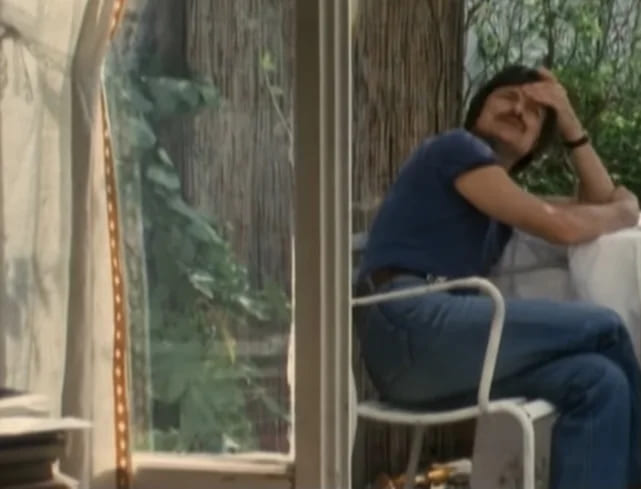To celebrate Andrei Tarkovsky’s birthday, a documentary film about the preparation for the filming of “Nostalgia” shot in 1982 called “Travel in Time” is being released in Russian theaters. It is viewed today through the eyes of Andrei Plakhov.
The credits of the film list Tonino Guerra and Tarkovsky himself as the directors. The Italian playwright, who had worked with Fellini and Antonioni, started by helping the Russian guest find the right locations for filming “Nostalgia.” He takes him in search of nature to the south, to the baroque town of Lecce, then to the picturesque Amalfi Coast, but all these beauties seem too touristy to Tarkovsky.

Photo: Genius s.r.l.
In “Nostalgia,” the character played by Oleg Yankovsky behaves similarly. The translator Eugenia, a beauty resembling a Renaissance portrait, brings Andrey Gorchakov to the monastery in the Tuscan town of Monterk to admire the magical “Madonna del Parto” by Piero della Francesca. However, the guest stubbornly refuses to go inside, grumbling, “I am tired of your beauties worse than bitter radishes.”
It is often said that due to a series of circumstances, Tarkovsky, having left Russia, deeply yearned for it, almost fell ill from it, and died not only from a cruel illness but primarily from separation from his homeland. It is believed that all these feelings the director expressed in the patriotic film “Nostalgia,” where the protagonist also dies abroad, foreshadowing Tarkovsky’s fate. And long before him, two centuries ago, another Russian talent, the serf musician Pavel Sosnovsky (prototype – composer Maxim Berezovsky), fell ill with nostalgia: he was sent to Italy by his owner, but could not bear this trial, returned home, and tragically ended his life. Gorckhov writes about Sosnovsky during his Italian trip but never finishes — thus partially repeating the fate of his character.
There is something wrong with this Italy: on the one hand, it attracts Russians like a magnet. On the other hand, it arouses anger and rejection. I have seen many “artists on assignment” (directors, actors, writers, journalists) dreaming of a trip abroad, but once there, locking themselves in their hotel rooms, drinking bitter drinks, or finding fellow countrymen with whom they can talk endlessly about their homeland’s fate. They feel good where they are not. At home, they suffer by default, and abroad, they suffer even more: we have enough fresh examples of this today. By the way, no one is stopping Gorckhov from returning home, but he chooses to linger in Italy.
It must be acknowledged that Tarkovsky portrayed his character (who in many ways resembles the director himself in narcissistic mannerisms) not without irony and even bitterness. It is even more absurd to see the revelations of current activists revising Russian culture through the lens of anti-imperialism, and also anti-male chauvinism: both of which are easily (sometimes with reason) attributed to Tarkovsky. In this view, Gorckhov is perceived as an embodiment of pretension, selfishness, and arrogance, as a mirror of questionable Russian spirituality. The words of the translator addressed to him, “You keep talking about freedom all the time, but you don’t know what freedom is,” are seen as the voice of truth. Of course, Russians hardly know about freedom in the sense that the translator mentions, and neither did Tarkovsky. But he knew something else, and so did his character.
Gorckhov understands the self-immolation of the holy fool prophet Domenico, possessed by fear and despair, sensing the “end of the world.” And from a foolish, mundane point of view, he follows Domenico’s idea – to carry a lit candle through the pool in Bagno Vignoni: this point of the “journey” will be his last. The absurd action is driven by a sense of helplessness: art cannot change the dying world. The only way to resolve this contradiction is to sacrifice oneself. And that is exactly what the protagonist and the author of “Nostalgia” essentially do. The most important aspect of “Travel in Time” is Tarkovsky’s words about how cinema is not just a profession for him, but is inseparable from his way of life and ultimately consumes, taking with it the very life of the filmmaker.
And what about nostalgia? It has not disappeared, but the problem for Tarkovsky is not with nostalgia itself. The longing for the motherland is a “long-debunked hassle.” Leaving Russia was just a part of the director’s destiny. A very important part, of course. What he truly suffered from, as seen in his detailed diaries, was the separation from his son: Soviet authorities, masters of psychological torture, kept him from leaving the country to join his father for a long time.
Tarkovsky was tormented by and attracted to the image of home, embodied by the family’s acquired house in the village of Myasnoye in the Ryazan region. Tarkovsky carries with him the image of the rural Russian dwelling in “Solaris” and in Tuscany, juxtaposed with ancient Roman Christian ruins in a symbolic frame. This is the peculiarity of Tarkovsky’s “nostalgia”: both Russia and Italy are beloved to him, but neither alone can satisfy his longing for an ideal.
Today, fears of nuclear war and the dramas of emigration are reproduced on a larger scale in the 21st century. And the film by Guerra and Tarkovsky becomes a journey through time – to an era when the world was divided by an iron curtain. Soon it will descend again, but space plays a subordinate role in this process. Time is the main player, which, compared to when Tarkovsky traveled through Italy, has sharply changed its quality and composition.

